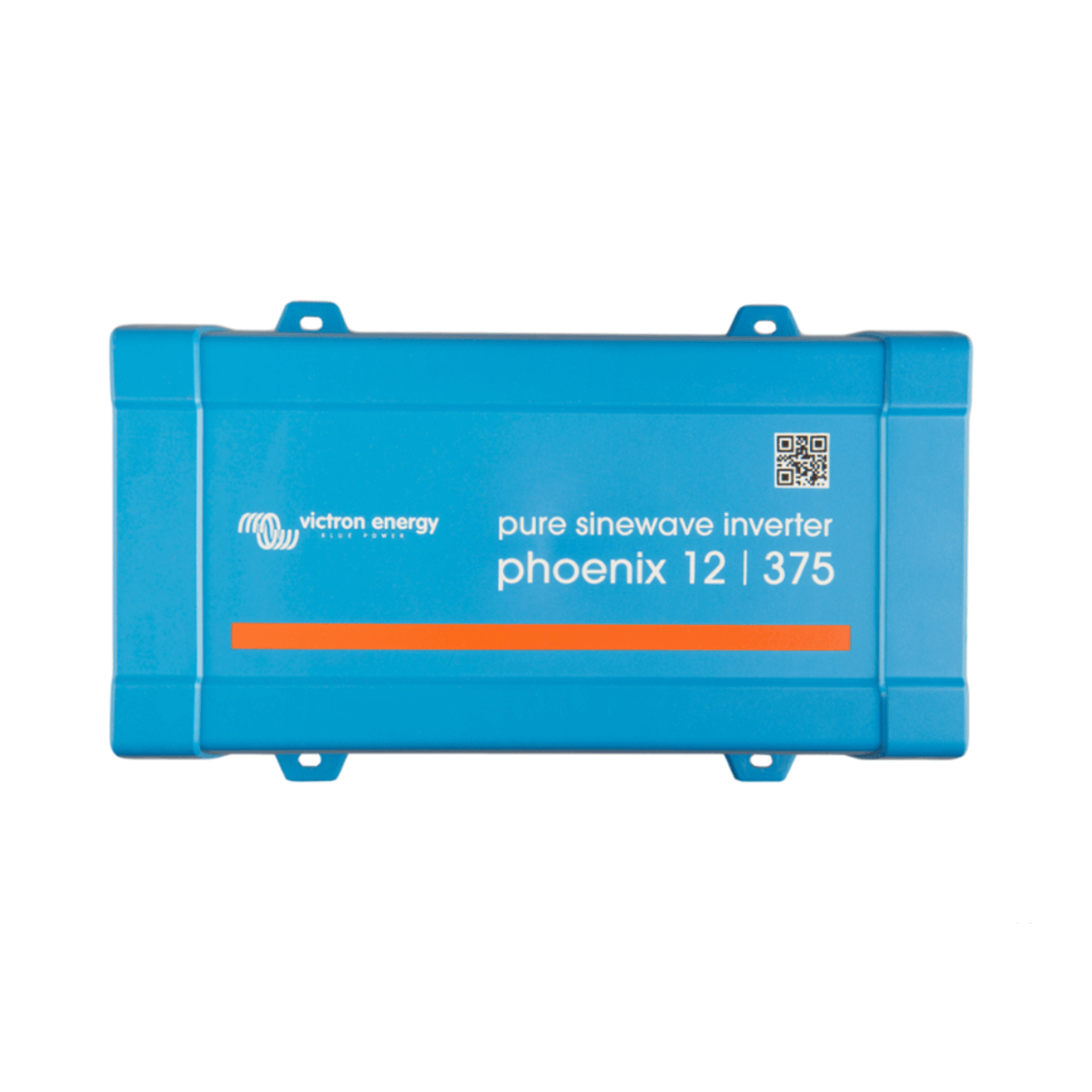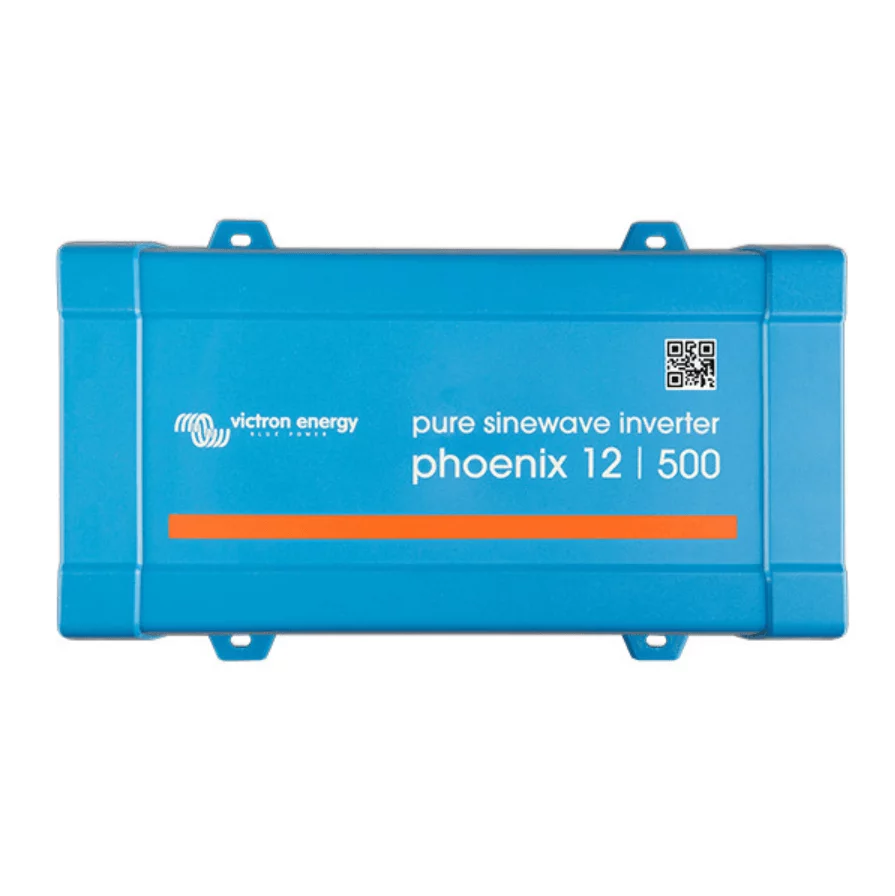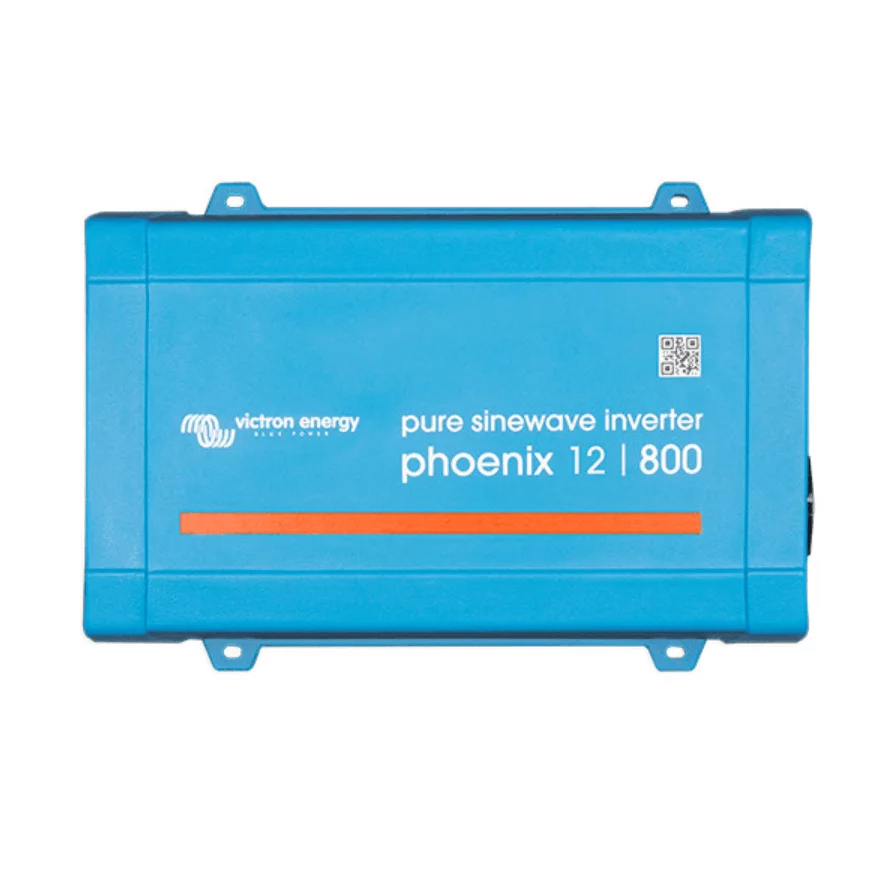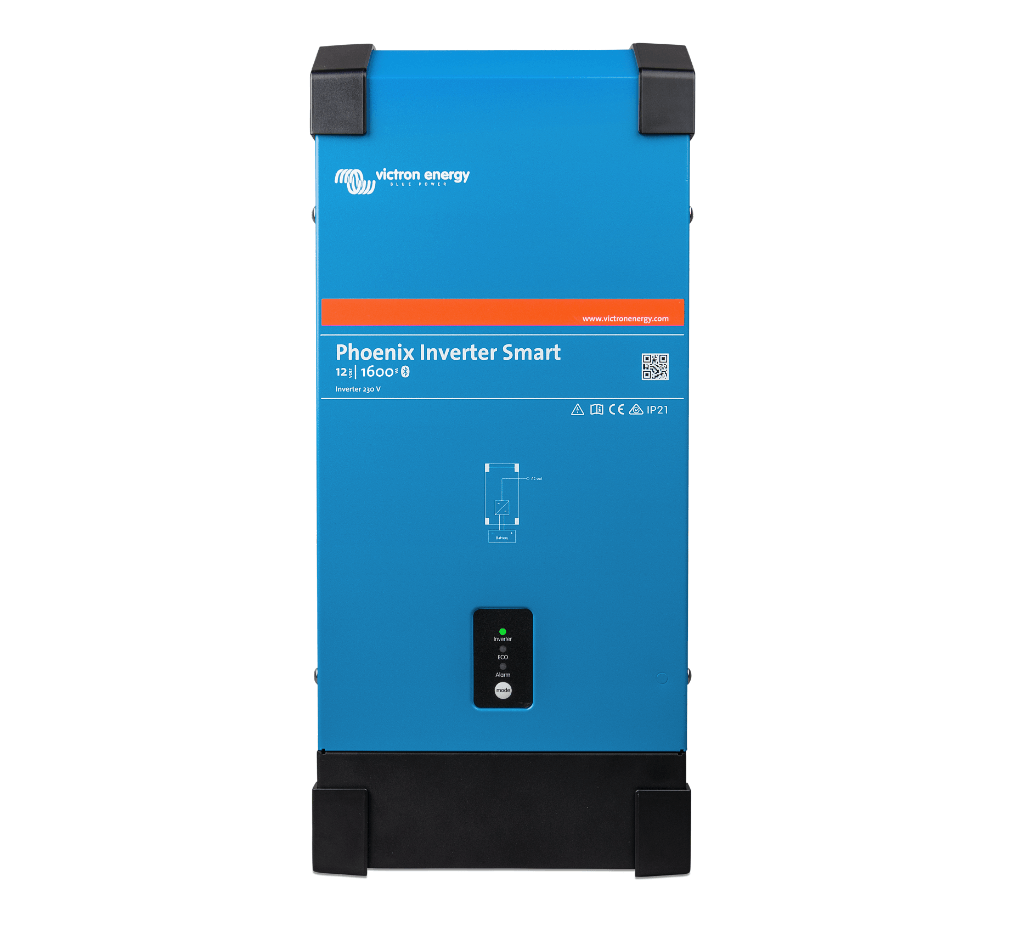What size inverter do I need for my campervan?
You know you need an inverter for your campervan, but you don’t know what type, or what size to choose? Let’s talk about how an inverter works, then we can do some calculations to work out what size you need for your van set-up.
How to size an inverter for a campervan
An inverter converts the low-voltage electricity from your leisure batteries (usually 12V) into the high-voltage electricity you use at home (~230V in most European countries, 120V in the US). This allows you to plug in appliances which need 230V to operate, like a toaster or a TV, and use them without being connected to shore power. We’ve already talked about how an inverter works, so let’s explain how to choose the right size inverter for your campervan electrical system.
There are two parameters which define the ‘size’ of an inverter. The system voltage is the voltage your batteries produce (usually 12V, although occasionally campervans use 24V), and the operating power describes how much power the inverter will be able to supply to your 230V appliances (measured in watts, W).
A note on volt-amps
Depending on the brand you buy, an inverter’s power output is rated in either watts (W) or volt-amps (VA). Before we dive in, it’s important to understand the difference so you can size your inverter correctly. VA denotes apparent power whereas W denotes real power, sometimes referred to as ‘total power’.
The difference between real power and apparent power is power factor. For some appliances, this is 1, which means that real power equals apparent power. But for other appliances, the power factor can be around 0.8, which means that the real power of an appliance can be ~80% of the apparent power.
Typically appliances with motors, such as power tools and blenders, have a power factor closer to 0.8. These are referred to as inductive loads. In contrast, most common appliances such as phone and laptop chargers and hair straighteners have a power factor close or equal to 1. Consequently, for these loads VA does equal W. Although an induction hob is an inductive load, its power factor is compensated for and so is usually close to 1.
So how does this affect what size inverter you should buy? For any loads that are inductive, divide their wattage rating by 0.8 to calculate their apparent power. If you’re unsure if a load is inductive or not, we would recommend dividing the wattage by 0.8 to ensure your inverter will definitely be able to power your loads. For more information, read our article about volt-amps vs watts.
How much power do I need?
Inverters are available in a range of wattages (e.g. 500W, 1200W, 3000W) and you need to work out which wattage you need to match your requirements. Firstly, try and predict which 230V appliances you will want to use in your campervan and find out their rated power draw.
You can usually find this printed somewhere on the appliance or on a label on the power cord (if not, you can normally google the specific product and find the specifications online). From this, you can work out what your maximum power draw will be at any one time.
For example, if you want to use a laptop charger (60W), a blender (800W) or a hairdryer (1600W), your max power usage will occur when you’re using the hairdryer: 1600W.
Remember, because a blender is an inductive load, we need to divide 800W by 0.8 to calculate its apparent power in VA.
One product in use at a time
60VA
or
1000VA
or
1600VA
Total = 1600VA
But if you want to reply to emails, blitz your kale smoothie and give yourself a fabulous blow-dry all at the same time, your max power usage will be 60W + 800W + 1600W = 2460W.
All products in use at the same time
60VA
or
1000VA
or
1600VA
Total = 2660VA
As it’s likely you’ll want to use more than one appliance at once, it’s important to factor the total wattage of all of your appliances into your inverter calculations.
The next step would seem obvious: pick an inverter with a power rating which is higher than your max power usage. However, there are a few other factors to take into account.
Reading the energy label
The rated power on an appliance label does not always describe the maximum power the appliance will draw. Some labels are more helpful than others and will provide an average power rating and a maximum power. But some products will only state an average power rating in an attempt to make the device seem more energy efficient than it actually is. This means that the power draw could spike up much higher than the stated power.
For example, most hair straighteners are rated somewhere between 35-75W. In actual fact, some hair straighteners will draw about 300W when they are first turned on and then gradually need less power as they reach a steady temperature. The inverter you choose needs to account for these high peaks in power to ensure it can power the device without causing damage.
How much can the inverter actually handle?
Let’s also consider what the rated power on the inverter means. Cheaper inverters will often advertise a power rating that is in fact their maximum power capacity, which it may only be able to maintain for a number of minutes.
Quality inverters, such as the Victron Phoenix inverters, give a rated power output which describes the maximum power which it can supply continuously and it can actually handle spikes in power which are usually about twice the rated continuous power – e.g. the Victron Phoenix 1200VA inverter has a rated peak power of 2400VA.
For example, Victron state that an overload of the inverter will occur if 130% of nominal power is drawn for more than 30 mins, and 150% can only be drawn for 5 seconds. With cheaper inverters, if you accidentally plug in an appliance which exceeds the total wattage, you may just blow a fuse, but you also run the risk of damaging the inverter or your appliance. If you opt for a model such as the Victron Phoenix inverter, the built-in protection feature will simply cut the power if you accidentally overload it.
So what size inverter do I need?
These uncertainties can make it difficult to choose the size of inverter you need, so we’d recommend always including a factor of safety above your predicted power usage to allow for these power differences and avoid damaging your inverter.
You also don’t want to choose an inverter that is rated much higher than your normal usage. Every inverter draws a little bit of its own power just to operate. For example, a 3000VA inverter will use 12W just to run without any load, so if you used it only to power a 60W laptop, it would actually draw 72W. This would be inefficient and will drain your battery quicker.
Still not sure which inverter to choose? Try out our free electrical system design service where we’ll do all the calculations for you. All you need to do is answer a series of questions about your usage and we’ll take care of the rest. We provide a free proposal for your system, and once you’ve purchased your components through us we’ll send over your free bespoke wiring diagram.
Campervan electrics leaving you confused?

Using appliances on grid vs off-grid
Remember that just because you can run high voltage appliances with an inverter, doesn’t mean your leisure batteries will be able to sustain that power draw for a long time. If you want to be able to explore off-grid for a number of days, using a lot of high wattage appliances could drain your battery quickly and force you to re-charge sooner than you’d like. This means that if you choose a high wattage inverter, you’ll need a battery bank that can provide that high power draw.
Charlie & Dale's 500VA inverter is big enough to power their laptops, drone charger and fairy lights!
If you plan to only ever use your campervan on campsites where you’ll be hooked up to shore power, you might not need an inverter at all. This will save a big chunk of your electrical system budget. You can simply bring the shore power directly into your van via a shore power inlet and a consumer unit which can power 230V plug sockets. This will also allow you to recharge your leisure batteries when you’re connected to hook up.
However, this does mean that you wouldn’t have the flexibility to use your 230V appliances when you’re parked up off-grid. A happy medium could be to have a smaller inverter from which you can still use some basic appliances like a laptop charger, speaker, etc. and accept that you can only use high power appliances when you’re on-grid.
Cost implications of inverter wattage
Larger inverters are of course more expensive, but the size of your inverter also has other cost implications. When a large amount of power is drawn through the inverter, the total current of your 12V system will also be large. High currents require bigger cable gauges and this also has a knock-on effect to other components such as busbars and switches. However, the main additional expense will be in buying a battery bank with the capacity to support this higher power usage, and being able to effectively recharge that battery bank with a larger solar panel array and bigger battery to battery charger.
The chart below highlights the affect increasing your inverter size has on the cost of the rest of your electrical system. As the inverter size increases, so does the required solar array, battery bank and associated components.
Please note that the chart is based on electrical systems using specific appliances which would require each size inverter and the costs are meant as an indication only, as this will vary largely based on a number of different variables.
If you want to understand how to install an campervan inverter, read of our article about how to wire a campervan electrical system.
What size inverter for a coffee maker?
To work out what size inverter you need for your coffee maker, you should check the rated power of your specific machine. If you don’t have your coffee maker yet, or you can’t find the rated power of the one you plan to use, we’ve done some research on typical power draws of different types of coffee maker.
Nespresso machines – 1200-1500W
- Nespresso Krups Pixie machine – 1260W
- Nespresso Essenza Mini Coffee Machine – 1310W
- Lakeland Coffee Pod Machine White – 1400W
- Aldi Ambiano Black Coffee Capsule Machine – 1450W
Drip coffee machines: 900-1100W
- KitchenAid Drip Coffee Maker – 1100W
- SMEG Drip Filter Coffee Machine – 1050W
- George Scandi Drip Coffee Machine – 900W
Espresso machines: 900-1500W
- Breville Mini Barista Coffee Machine – 1300W
- Krups Opio Pump Machine – 1140W
- Adexa 2 in 1 Espresso Machine – 850W
- KitchenAid Espresso Machine – 1500W
Electric milk frothers: around 500W
- Nespresso milk frother – 500W
- Salter milk frother – 500W
- VonShef – 550W
For most coffee makers, you’ll need a 1200VA or 1600VA inverter. The exact size of inverter you will need will depend on your specific model. As there is a fair bit of variation between products, it’s always best if you can get the rating of your specific machine.
If you’re thinking about bringing one of these machines along on your van adventures, remember that weight and space are always things you want to be aware of too. It’s worth considering other ways to achieve the perfect brew. Here are some ideas for coffee making which use less power and are much smaller and lighter.
Alternative coffee makers
A stove-top percolator (also known as a Moka pot) is a great way to achieve an almost espresso-like coffee with only the power of your gas stove and come in a couple different sizes. There are also a couple of newer technologies that are great alternatives such as the Aeropress or the Handpresso pump.
The Handpresso works a little bit like a bike pump, just add some ground coffee and a bit of hot water, pump the device to build up the pressure, then press a button to release the water through the coffee. This method might be perfect for you if you don’t mind putting a little effort into your morning brew!
The Aeropress works similarly, where the hot water is forced through the coffee by pushing down on a syringe-like assembly. And don’t forget, if you don’t need a strong espresso, a good old-fashioned cafetiere will do the job electricity-free (but be careful with that fragile glass container!).


Alternative milk frothers
There are also ways to get smooth, frothy milk without a 230V milk frother: some people use something that looks just like a cafetiere, where the mesh disk is pumped back and forth to force air into the milk and others swear by the handheld, battery powered whisk-style frother.
Still want the luxury of your beloved Nespresso machine along with you on your travels? Have a look at the Victron inverters we sell on our website.
What size inverter to charge a laptop?
Laptops normally operate around 16-20V DC and draw a surprisingly small current, and therefore only need a small amount of power to charge. Here’s some examples of typical laptop power draw:
Standard laptops
- MacBook Air – 30-45W
- Dell XPS 13 – 45W
- Asus Zenbook 13 – 65W
Gaming laptops
- Lenovo Legion – 300W
- Acer Predator Triton 300 SE – 230W
Even the smallest rated inverters will be able to charge a standard laptop with room to spare. If your largest 230V appliance is your laptop, you should be able to use a 250VA inverter for most laptops, or you might need a 500VA inverter for a gaming laptop which draw a bit more power.
We normally recommend a 500VA inverter as a minimum; for the extra cost, a 500VA inverter will allow you to use a couple of different low power 230V appliances, such as a small blender or hair straighteners. This will give you flexibility for any new gadgets you find in the future and will make your van more universally usable for future resale.


Can I use a 12V laptop charger?
When you plug a laptop into 230V AC power, the little Power Supply Unit box on your charger (or if you have a Mac, this is built into the plug) converts the 230V AC power into a low voltage DC power. So when you use an inverter, you are stepping up the voltage from 12V to 230V, only for the charger to step it back down again to around 17-19V.
A DC-DC boost converter plugs into a 12V cigarette lighter socket. This will directly step up the voltage from 12V to around 17V, without having to convert to 230V AC in between. Since different laptops require slightly different voltages, it’s possible to buy specific boost converters for your laptop. There are accounts that claim these work perfectly well, however, there are also a lot of reports of these products either not working at all, or overheating and melting which is a massive fire risk!
You can find products like this on Amazon or eBay, but we would recommend by-passing the risk of unbranded products and sticking with an inverter system where you can choose a reputable brand. Additionally, some laptops will only charge from pre-approved chargers which have an identification chip inside them, therefore won’t work with an off-market charger even if it does provide the correct current.
What size inverter do I need for a TV?
There are lots of ways to watch TV in your van, so you don’t have to worry about missing out on the latest episode of Love Island on your next van trip! Some people choose to watch TV on their laptop or iPad – if you have campervan WiFi you can happily spend rainy days bingeing Netflix. Others like to create a mini movie theatre by using a portable projector and screen. And of course, some people choose to install a TV.
230V TVs
You will only need a small 250VA inverter to power a TV, as most of them have a low wattage around 18-50W. Here’s the power rating of a couple of different 230V TVs:
- Hisense 43” 4K Smart TV – 51W
- Samsung 32” HD LED Smart TV – 33W
- Samsung 24” Smart HD Ready TV – 21W
- LG 22” Full HD LED TV Monitor – 18W
12V TVs
Although the power draw of 240V TVs is pretty small, and would work fine with the smallest inverters, there is another alternative: 12V TVs are now available! Like the 12V 24” Cello Electronics Smart Android TV which has a power rating of 36W and seems to do all the things your regular 240V TV can do! It comes in a range of sizes (16” to 24”). Another popular 12V TV is the Avtex Smart DSFVP TV (17W) which is Full HD, comes in 19.5, 21.5 or 24 inches, and even comes with an on-screen leisure battery meter so you can keep an eye on your consumption. Here’s an article with a list of 12V TVs currently on the market and a breakdown of their key features. If you install a 12V TV in your campervan, you won’t require an inverter to power it.
Both 240V and 12V TVs are a viable option for a campervan set up but will take up a fair bit of space mounted on your wall. If you want to save on space and weight, it might be worth just using a laptop or iPad to watch TV, and remember, van life can bring you to so many spectacular places! Don’t forget to explore, even on bad weather days.
What size inverter for a hairdryer?
Hairdryers are the most common product which we find people are really keen to use in their van. But the first question is – do you really need a hairdryer? In the summer, letting hair air-dry is always an option, but in cooler climates, having wet hair for even a short amount of time can make you feel pretty chilled. We find that if you have access to a shower, you usually have access to power too e.g. at a campsite or at a friend’s house. But if you have a shower in your van which can be used off-grid, you might want to be able to use a hairdryer too.
How much power does a hairdryer use?
Remember to check the label of your hairdryer to see how much power it draws, but here’s a couple of examples of hairdryers and their power ratings:
- Dyson Supersonic Hair Dryer 1600W
- Red by Kiss Ceramic 2000 Ionic Blow Dryer – 2000W
- TRESemme Power Hair Dryer – 2200W
- MHD Berta Travel Mini Hair Dryer – 1000W
- BaByliss Pro Nano Bambino Dryer – 1000W
Most hairdryers can be powered by a 1600VA inverter. If your current hairdryer has a high power rating (~2000W), it might be worth investing in a travel hairdryer which has been specifically designed to use less power and are normally more compact. This would allow you to forgo the 2000/3000VA inverter for a 1200VA or 1600VA inverter, eating into less of your total conversion budget. Here’s a review of some popular low wattage hair dryers.
12V hairdryers
12V hairdryers do exist, but a quick scan of the reviews left on Amazon will quickly make you doubt how effective they are! The reality is, creating heat from electricity is actually a very inefficient process and will always require a lot of power. A more efficient method of creating heat is the burning of diesel fuel, just like your diesel air heater…full marks will be given to anyone who manages to create a hairdryer attachment for your diesel heater outlet!
What size inverter for an induction hob?
Installing an induction hob in your campervan is a bold move! Creating heat from electricity always requires bucket loads of power, and producing all that power from 12V batteries will have big consequences on your conversion budget.
But maybe you’re confident that you’re always going to have good access to solar power, or maybe you know you’re always going to be hooked up to shore power whenever you’re cooking, or maybe you just can’t imagine life without your beloved induction hob you use at home. It is totally possible, but you will just need a big, powerful electrical system to handle the power draw. Read our article about using an induction hob in your campervan to see the full power calculations and the affect it will have on your electrical system.
Power rating of an induction hob
Most domestic 2 ring induction hobs draw over 3000W which would over-power even the largest campervan inverter available, so you’re better off finding a ‘lower wattage’ induction hob which has been specifically designed for use in a campervan.
For example, the Sterling Power IH1 single ring induction hob has a maximum wattage of 1500W, and the Thetford Topline 902 double ring induction hob has a maximum wattage of 2300W. This means it’s very likely that you’ll need a 3000VA inverter if you want to run an induction hob in your campervan.
Always going to be plugged into shore power?
For those who will exclusively use campsites, an induction hob might make sense. When you’re connected to a campsite hook up, your power comes directly from the campsite power supply rather than your leisure batteries. This means that you have an almost endless supply of power whilst plugged into hook up.
The caveat here is that campsites have hook ups rated to 16A, so you will only be able to access a maximum wattage of 16A x 230V = 3680W. If you use any more than this, you will trip the campsite post (i.e. blow the fuse inside the hook up) and likely get charged by the campsite to turn this back on. Therefore, even if you plan on spending all of your time on campsites, you should ensure that your total power usage doesn’t exceed ~3000W.
Campervan electrics leaving you confused?













Superhelpful! Thank you! Now I’m left wondering about hair straighteners…. and if I can really live without them! ha ha ha!